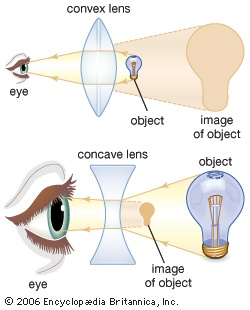focusing
optics
also called ocular accommodation
 ability of the lens to alter its shape to allow objects to be seen clearly.
ability of the lens to alter its shape to allow objects to be seen clearly. In humans, the forward surface of the lens is made more convex for seeing objects up close. At the same time, the pupil becomes smaller, and the two eyes (eye, human) turn inward (i.e., cross or converge) to the point that their gaze is fixed on the object. The capsule, or envelope enclosing the lens of the eye, is attached by suspensory ligaments (ligament) (called zonular fibres) to the ringlike ciliary muscle that encircles the lens. The inside diameter of this muscle is greatest when the muscle is relaxed and smallest when the muscle is contracted. Thus, when the gaze is fixed on a distant object, as when a camera is set at infinity, the ciliary muscle (ciliaris muscle) relaxes, the muscle's inside diameter is increased, more pull is exerted on the lens by the ligaments, and the front surface of the lens is flattened. When near objects are viewed, the ciliary muscle contracts, the ligaments relax, and the lens, being elastic, bulges in front and gains more curvature. This increased curvature enhances the focusing power of the lens and brings the nearer object to better focus on the retina. This process, known as accommodation, is controlled by parasympathetic fibres of the third (oculomotor) cranial nerve. As a person ages, the lens hardens and slowly loses its ability to change shape and bring near objects into better focus. This condition is called presbyopia and generally becomes evident after age 40.
In humans, the forward surface of the lens is made more convex for seeing objects up close. At the same time, the pupil becomes smaller, and the two eyes (eye, human) turn inward (i.e., cross or converge) to the point that their gaze is fixed on the object. The capsule, or envelope enclosing the lens of the eye, is attached by suspensory ligaments (ligament) (called zonular fibres) to the ringlike ciliary muscle that encircles the lens. The inside diameter of this muscle is greatest when the muscle is relaxed and smallest when the muscle is contracted. Thus, when the gaze is fixed on a distant object, as when a camera is set at infinity, the ciliary muscle (ciliaris muscle) relaxes, the muscle's inside diameter is increased, more pull is exerted on the lens by the ligaments, and the front surface of the lens is flattened. When near objects are viewed, the ciliary muscle contracts, the ligaments relax, and the lens, being elastic, bulges in front and gains more curvature. This increased curvature enhances the focusing power of the lens and brings the nearer object to better focus on the retina. This process, known as accommodation, is controlled by parasympathetic fibres of the third (oculomotor) cranial nerve. As a person ages, the lens hardens and slowly loses its ability to change shape and bring near objects into better focus. This condition is called presbyopia and generally becomes evident after age 40.- Tokugawa Hidetada
- Tokugawa Iemitsu
- Tokugawa Ieyasu
- Tokugawa Mitsukuni
- Tokugawa Nariaki
- Tokugawa period
- Tokugawa Tsunayoshi
- Tokugawa Yoshimune
- Tokugawa Yoshinobu
- Tokushima
- Tokutomi Roka
- Tokutomi Sohō
- Tokuyama
- Tokyo
- Tokyo Bay
- Tokyo National Museum
- Tokyo Stock Exchange
- Tokyo, University of
- Tokyo-Yokohama earthquake of 1923
- Tokyo-Yokohama Metropolitan Area
- Tolain, Henri-Louis
- Toland, Gregg
- Toland, John
- Tolan, Eddie
- tolbutamide